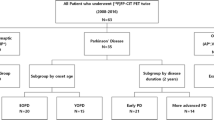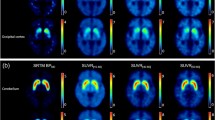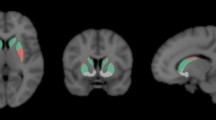Abstract
To investigate the usefulness of 18F-FP-CIT PET for assessing the severity of Parkinson’s disease (PD) at various clinical stages, 41 patients with PD were divided into early (Hoehn&Yahr I-II, n = 23) and advanced (Hoehn&Yahr III-IV, n = 18) subgroups. 18F-FP-CIT PET was performed in these patients and 12 normal subjects. 18F-FP-CIT uptake in striatal subregions and its correlation with UPDRS were first evaluated by ROI analysis, and between-group differences were also analyzed by Statistical Parametric Mapping (SPM). Our results showed that striatal 18F-FP-CIT binding were significantly reduced to 70.9% (caudate), 46.8% (anterior putamen) and 24.0% (posterior putamen) in early PD compared with that of the control, and to 52.0%, 34.5% and 16.5% correspondingly in advanced PD, respectively. There was significant negative correlation between total motor UPDRS score of all parkinsonian patients and 18F-FP-CIT uptake in caudate nucleus (r = −0.53, p < 0.001), anterior putamen (r = −0.53, p < 0.001) and posterior putamen (r = −0.61, p < 0.001). SPM comparison of 18F-FP-CIT uptake between early or advanced PD and the control group showed significant decline in striatum, predominantly localized on the contralateral side and in the dorsal-posterior putamen. These results indicate that 18F-FP-CIT PET can serve as a suitable biomarker to represent the severity of PD in early and advanced stages.



Similar content being viewed by others
References
Booij J, Habraken JB, Bergmans P, et al. (1998) Imaging of dopamine transporters with iodine-123-FP-CIT SPECT in healthy controls and patients with Parkinson’s disease. J Nucl Med 39:1879–1884
Ribeiro MJ, Vidailhet M, Loc’h C, et al. (2002) Dopaminergic function and dopamine transporter binding assessed with positron emission tomography in Parkinson disease. Arch Neurol 59:580–586
Rinne JO, Ruottinen H, Bergman J, et al. (1999) Usefulness of a dopamine transporter PET ligand [(18)F]beta-CFT in assessing disability in Parkinson’s disease. J Neurol Neurosurg Psychiatry 67:737–741
Morrish PK, Rakshi JS, Bailey DL, et al. (1998) Measuring the rate of progression and estimating the preclinical period of Parkinson’s disease with [18F]dopa PET. J Neurol Neurosurg Psychiatry 64:314–319
Kazumata K, Dhawan V, Chaly T, et al. (1998) Dopamine transporter imaging with fluorine-18-FPCIT and PET. J Nucl Med 39:1521–1530
Kung HF, Kim HJ, Kung MP, et al. (1996) Imaging of dopamine transporters in humans with technetium-99 m TRODAT-1. Eur J Nucl Med 23:1527–1530
Huang WS, Chiang YH, Lin JC, et al. (2003) Crossover study of (99 m)Tc-TRODAT-1 SPECT and (18)F-FDOPA PET in Parkinson’s disease patients. J Nucl Med 44:999–1005
Rinne OJ, Nurmi E, Ruottinen HM, et al. (2001) [(18)F]FDOPA and [(18)F]CFT are both sensitive PET markers to detect presynaptic dopaminergic hypofunction in early Parkinson’s disease. Synapse 40:193–200
Tedroff J, Ekesbo A, Rydin E, et al. (1999) Regulation of dopaminergic activity in early Parkinson’s disease. Ann Neurol 46:359–365
Ishikawa T, Dhawan V, Kazumata K, et al. (1996) Comparative nigrostriatal dopaminergic imaging with iodine-123-beta CIT-FP/SPECT and fluorine-18-FDOPA/PET. J Nucl Med 37:1760–1765
Wang GJ, Volkow ND, Fowler JS, et al. (1995) Comparison of two pet radioligands for imaging extrastriatal dopamine transporters in human brain. Life Sci 57:L187-L191
Guttman M, Burkholder J, Kish SJ, et al. (1997) [11C]RTI-32 PET studies of the dopamine transporter in early dopa-naive Parkinson’s disease: implications for the symptomatic threshold. Neurology 48:1578–1583
Ilgin N, Zubieta J, Reich SG, et al. (1999) PET imaging of the dopamine transporter in progressive supranuclear palsy and Parkinson’s disease. Neurology 52:1221–1226
Laakso A, Bergman J, Haaparanta M, et al. (1998) [18F]CFT [(18F)WIN 35,428], a radioligand to study the dopamine transporter with PET: characterization in human subjects. Synapse 28:244–250
Robeson W, Dhawan V, Belakhlef A, et al. (2003) Dosimetry of the dopamine transporter radioligand 18F-FPCIT in human subjects. J Nucl Med 44:961–966
Ma Y, Dhawan V, Mentis M, et al. (2002) Parametric mapping of [18F]FPCIT binding in early stage Parkinson’s disease: a PET study. Synapse 45:125–133
Eshuis SA, Maguire RP, Leenders KL, et al. (2006) Comparison of FP-CIT SPECT with F-DOPA PET in patients with de novo and advanced Parkinson’s disease. Eur J Nucl Med Mol Imaging 33:200–209
Nurmi E, Ruottinen HM, Kaasinen V, et al. (2000) Progression in Parkinson’s disease: a positron emission tomography study with a dopamine transporter ligand [18F]CFT. Ann Neurol 47:804–808
Nurmi E, Bergman J, Eskola O, et al. (2003) Progression of dopaminergic hypofunction in striatal subregions in Parkinson’s disease using [18F]CFT PET. Synapse 48:109–115
Marek K, Innis R, van Dyck C, et al. (2001) [123I]beta-CIT SPECT imaging assessment of the rate of Parkinson’s disease progression. Neurology 57:2089–2094
Benamer HT, Patterson J, Wyper DJ, et al. (2000) Correlation of Parkinson’s disease severity and duration with 123I-FP-CIT SPECT striatal uptake. Mov Disord 15:692–698
Hughes AJ, Daniel SE, Kilford L, et al. (1992) Accuracy of clinical diagnosis of idiopathic Parkinson’s disease: a clinico-pathological study of 100 cases. J Neurol Neurosurg Psychiatry 55:181–184
Pellizari CA, Chen GTY, Spelbring DR (1989) Accurate three-dimensional registration of CT, PET and/or MR images of the brain. J Comput Assist Tomogr 13:20–26
Talairach J, Tournoux P (1988) Co-planar stereotaxic atlas of the human brain. Thieme, Stuttgart
Ma Y, Dhawan V, Spetsieris P, et al. (2002) Comparison of Mapping Parameters in 18F-FPCIT imaging of early stage Parkinson’s disease. In: Michio Senda, Yuichi Kimura, Peter Herscovitch (eds) Brain imaging using PET. Academic Press, San Diego, pp 277–283
Carbon M, Ma Y, Barnes A, et al. (2004) Caudate nucleus: influence of dopaminergic input on sequence learning and brain activation in Parkinsonism. Neuroimage 21:1497–1507
Asenbaum S, Brucke T, Pirker W, et al. (1997) Imaging of dopamine transporters with iodine-123-beta-CIT and SPECT in Parkinson’s disease. J Nucl Med 38:1–6
Seibyl JP, Marek KL, Quinlan D, et al. (1995) Decreased single-photon emission computed tomographic [123I]beta-CIT striatal uptake correlates with symptom severity in Parkinson’s disease. Ann Neurol 38:589–598
Antonini A, Moresco RM, Gobbo C, et al. (2001) The status of dopamine nerve terminals in Parkinson’s disease and essential tremor: a PET study with the tracer [11-C]FE-CIT. Neurol Sci 22:47–48
Morrish PK (2003) How valid is dopamine transporter imaging as a surrogate marker in research trials in Parkinson’s disease? Mov Disord 18(Suppl 7):S63-S70
Ravina B, Eidelberg D, Ahlskog JE (2005) The role of radiotracer imaging in Parkinson disease. Neurology 64:208–215
Acknowledgement
We thank Dr. Yilong Ma at North Shore University Hospital in New York for his critical review of this manuscript and for gracefully providing a 3D stereotactic PET brain template for 18F-FP-CIT binding. We also gratefully acknowledge the financial supports from China’s National Key Technologies R&D Program in the 10th five-year plan (2001BA702B02) and Key Research Grants of Health Department in Jiangsu Province (H2008).
Author information
Authors and Affiliations
Corresponding author
Additional information
Received in revised form: 11 June 2006
Rights and permissions
About this article
Cite this article
Wang, J., Zuo, CT., Jiang, YP. et al. 18F-FP-CIT PET imaging and SPM analysis of dopamine transporters in Parkinson’s disease in various Hoehn & Yahr stages. J Neurol 254, 185–190 (2007). https://doi.org/10.1007/s00415-006-0322-9
Received:
Accepted:
Published:
Issue Date:
DOI: https://doi.org/10.1007/s00415-006-0322-9




